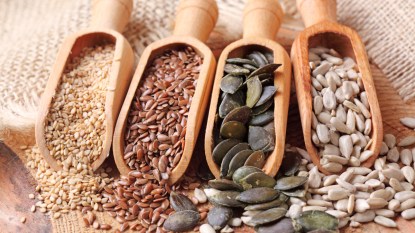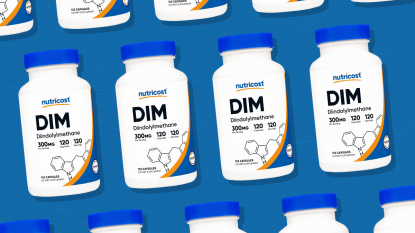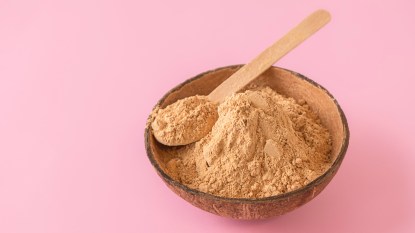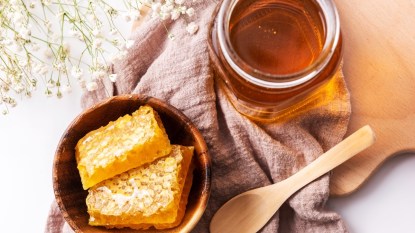Study: The Delicious Snack Proven To Reduce Hot Flashes By 79%
A gynecologist explains how to use soy to dramatically reduce the #1 symptom of menopause

Hot flashes are one of the most common, and dreaded, side effects of menopause. Officially dubbed vasomotor symptoms (VMS), the episodes can run the gamut from a mild, slightly warm flushing to producing intense heat — usually involving the head, neck, chest and upper back — accompanied by profuse sweating for up to five minutes. And for many women, hot flashes can go on for years, often beginning in a woman’s 40s and lasting well into her 50s and even 60s. And, although 80% of women will experience hot flashes at some point, there isn’t a consensus on the best way to treat them. Until now. A promising study has found an easy and delicious way to keep hot flashes at bay: Add soy to your diet.
How soy tames hot flashes
In a 12-week study done by the Physicians’ Committee for Responsible Medicine and published in the journal Menopause, researchers split postmenopausal women who experienced at least two hot flashes daily into two groups: One group continued to eat their normal diet and the other ate a plant-based vegan diet that included 1/2 cup of cooked soybeans daily. Neither group used medication or other interventions to manage their symptoms.
The results were astounding: Those who ate the soybeans reduced the number of hot flashes by 79%. More than half of the soybean group said their moderate-to-severe episodes disappeared altogether. The control group, on the other hand, saw no change in hot flash frequency, duration or intensity. What’s more, the soybean group experienced other anecdotal perks after the three-month protocol, including better sleep and digestion, weight loss and improved overall quality of life.
“Soy contains isoflavones, plant estrogens [phytoestrogens] that reduce hot flashes,” explains Felice Gersh MD, medical director of the Integrative Medical Group of Irvine. These compounds have a similar molecular structure to estrogen, which decreases significantly as women age, a drop that’s responsible for many menopausal symptoms. The similar molecular structure of the plant estrogens allows them to turn on estrogen receptors and thus reduce any and all menopause symptoms triggered by falling estrogen levels. Click through to see how phytoestrogens and probiotics helped one women overcome her perimenopause symptoms)
Is it safe to eat soy?
Certain breast tumors contain high levels of estrogen, so for years, women with a family history of breast cancer were advised to avoid soy, says ob/gyn Barbara DePree, MD. But new research suggests that it’s safe to enjoy one to two servings per day of whole soy foods. In fact, some studies have found eating soy-based foods may lower the risk of breast cancer. What’s more, soy contains protein and fiber that bring other health benefits, like preventing constipation and helping you feel fuller longer, which can help you avoid weight gain. Says Dr. Gersh: “It’s important to look for organic or nongenetically modified (non-GMO) soy.” (Get the details here on how eliminating GMOs can help you lose weight)
The most delicious forms of soy
While it’s easy and inexpensive to cook up soybeans in a crock pot or Instant Pot, they’re even tastier roasted into a crunchy snack. One spicy approach:
Another delicious snack or side dish option: edamame, which are young soybeans that are harvested while the pods are still soft. They taste a little bit like sugar snap peas and are widely available shelled or in the pod, fresh or frozen. Edamame are especially tasty in the pod, heated for 20 seconds in the microwave and lightly salted.

Finally, soy milk is widely available and can be incorporated into smoothies, sauces or simply sipped on its own.
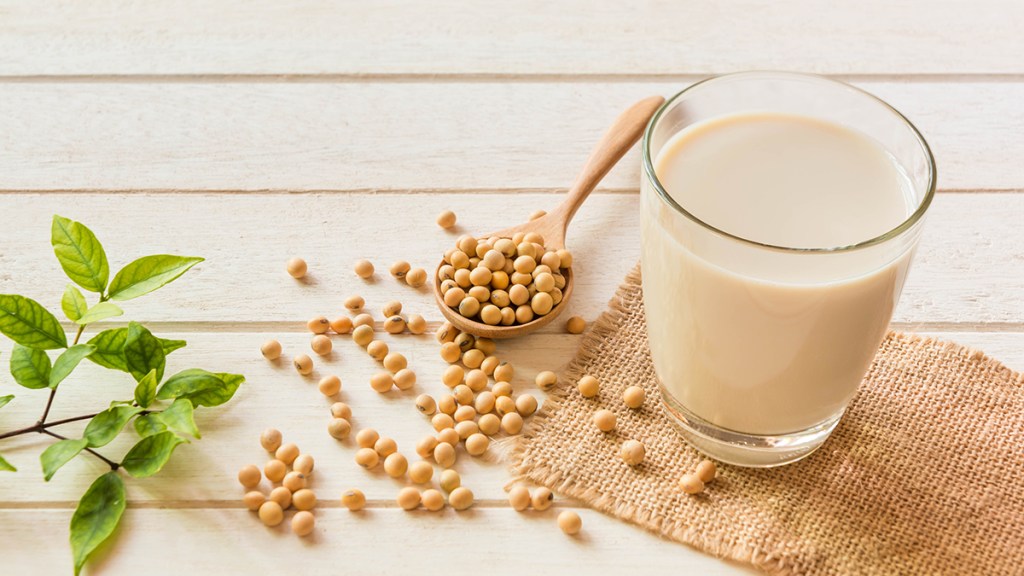
Does soy work for everyone?
“Whether or not soy will work for you depends on your ability to convert soy into equol, an estrogen-mimicking compound,” says Laura Corio, MD, author of The Change Before the Change. In fact, a study in the Journal of Nutrition found that about half of us have the necessary gut bacteria to produce equol, making soy effective. But for the half of us unable to produce equol, soy has no effect on taming hot flashes, says Dr. Corio.
Thankfully, there’s a workaround in the form of an equol supplement. A study in the Journal of Women’s Health found that postmenopausal women not able to make S-equol, but who supplemented with 10 mg daily, cut hot flash frequency in half, plus reduced the severity of the episodes they did have. A supplement with the study-proven dose: Equelle (buy from Equelle, $40).
More ways to outsmart hot flashes
Soy isn’t the only strategy shown to lower hot flash risk and intensity. Here are a few other natural remedies:
Take a ‘balloon’ break
Scientists at the Mayo Clinic discovered that women who used a relaxing belly breathing technique called paced breathing reduced hot flashes by 52%. The key? Slowing your breathing rate to six breaths a minute for 15 minutes twice daily. Paced breathing, in which you feel your stomach rise and fall as inflating and deflating a balloon, improves blood vessels’ ability to dilate to better regulate your body temperature, according to the American Journal of Medicine. To do: Inhale deeply for a count of four as you feel your stomach expand. Then lightly purse your lips and slowly exhale for a count of six as your stomach contracts.
‘Air condition’ your neck
Accessorizing an outfit like an athlete — with an affordable “cooling scarf” — may ease flushing for the 87% of women who experience hot flashes. Wayne State University School of Medicine research suggests keeping your body’s “internal thermostat” at the ideal temperature blocks it from tipping over into a higher core temp that triggers flashes. The bandana-like scarves use a high-tech fabric that feels totally dry but invisibly evaporates water molecules, acting like a wearable air-conditioner. Plus, Israeli research finds that, compared to cooling other parts of your body, chilling your neck lowers your core temperature 250% more efficiently. One to try: Mission Cooling Bandana (buy from Amazon, $14.99).
Enjoy a pre-dinner mocktail
Drinking a small glass of unsalted tomato juice twice daily (try a plain glass before breakfast and a Bloody Mary mocktail before dinner) significantly reduces menopausal symptoms including hot flashes, report Japanese researchers. Credit goes to tomatoes’ high levels of gamma-aminobutyric acid, a compound that mimics estrogen. This compound stabilizes hormones responsible for flushing, helping to regulate body temperature from the inside out.
Try a cooling spritz
Keeping skin cool — especially in areas where blood flows close to skin surface, like inside the wrists, the chest and the back of the neck — can help tame hot flashes, says Dr. Corio, who recommends using one with aloe vera (it cools skin on contact) or peppermint oil. Researchers at Wake Forest University in Winston-Salem, North Carolina, found that the menthol in peppermint activates cold receptors on nerve cells. This produces a cooling effect similar to what you’d feel if you applied cold temperatures directly to your skin. A spray with both: Garner’s Garden Cool Down Hot Flash Spray (buy it from Garner’s Garden, $6.99). Another option: Store peppermint essential oil or aloe vera gel in the fridge and dab it on your wrists, chest and neck when you feel a hot flash coming on.
For more tips on managing menopausal symptoms, check out these articles
13 Best Menopause Pajamas for Night Sweats to Keep You Cool All Night Long
Do Menopause Symptoms Require Medications? These Natural Remedies Suggest Otherwise
Can Kombucha Make Menopause Symptoms More Manageable? We Asked the Experts
The 9 Best Foods That Fight Hot Flashes, According to MDs — No Medication Required
This story originally appeared in our print magazine.
This content is not a substitute for professional medical advice or diagnosis. Always consult your physician before pursuing any treatment plan.


